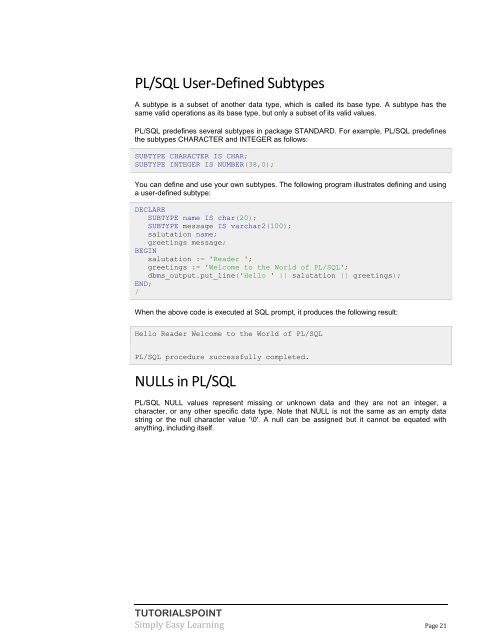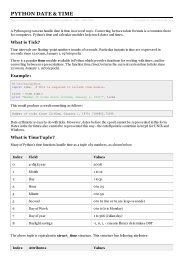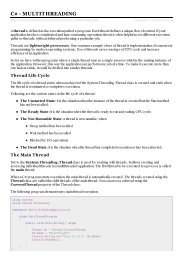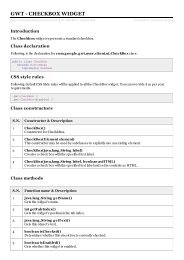download pl/sql tutorial (pdf - Tutorials Point
download pl/sql tutorial (pdf - Tutorials Point
download pl/sql tutorial (pdf - Tutorials Point
You also want an ePaper? Increase the reach of your titles
YUMPU automatically turns print PDFs into web optimized ePapers that Google loves.
PL/SQL User-Defined Subtypes<br />
A subtype is a subset of another data type, which is called its base type. A subtype has the<br />
same valid operations as its base type, but only a subset of its valid values.<br />
PL/SQL predefines several subtypes in package STANDARD. For exam<strong>pl</strong>e, PL/SQL predefines<br />
the subtypes CHARACTER and INTEGER as follows:<br />
SUBTYPE CHARACTER IS CHAR;<br />
SUBTYPE INTEGER IS NUMBER(38,0);<br />
You can define and use your own subtypes. The following program illustrates defining and using<br />
a user-defined subtype:<br />
DECLARE<br />
SUBTYPE name IS char(20);<br />
SUBTYPE message IS varchar2(100);<br />
salutation name;<br />
greetings message;<br />
BEGIN<br />
salutation := 'Reader ';<br />
greetings := 'Welcome to the World of PL/SQL';<br />
dbms_output.put_line('Hello ' || salutation || greetings);<br />
END;<br />
/<br />
When the above code is executed at SQL prompt, it produces the following result:<br />
Hello Reader Welcome to the World of PL/SQL<br />
PL/SQL procedure successfully com<strong>pl</strong>eted.<br />
NULLs in PL/SQL<br />
PL/SQL NULL values represent missing or unknown data and they are not an integer, a<br />
character, or any other specific data type. Note that NULL is not the same as an empty data<br />
string or the null character value '\0'. A null can be assigned but it cannot be equated with<br />
anything, including itself.<br />
TUTORIALSPOINT<br />
Sim<strong>pl</strong>y Easy Learning Page 21

















